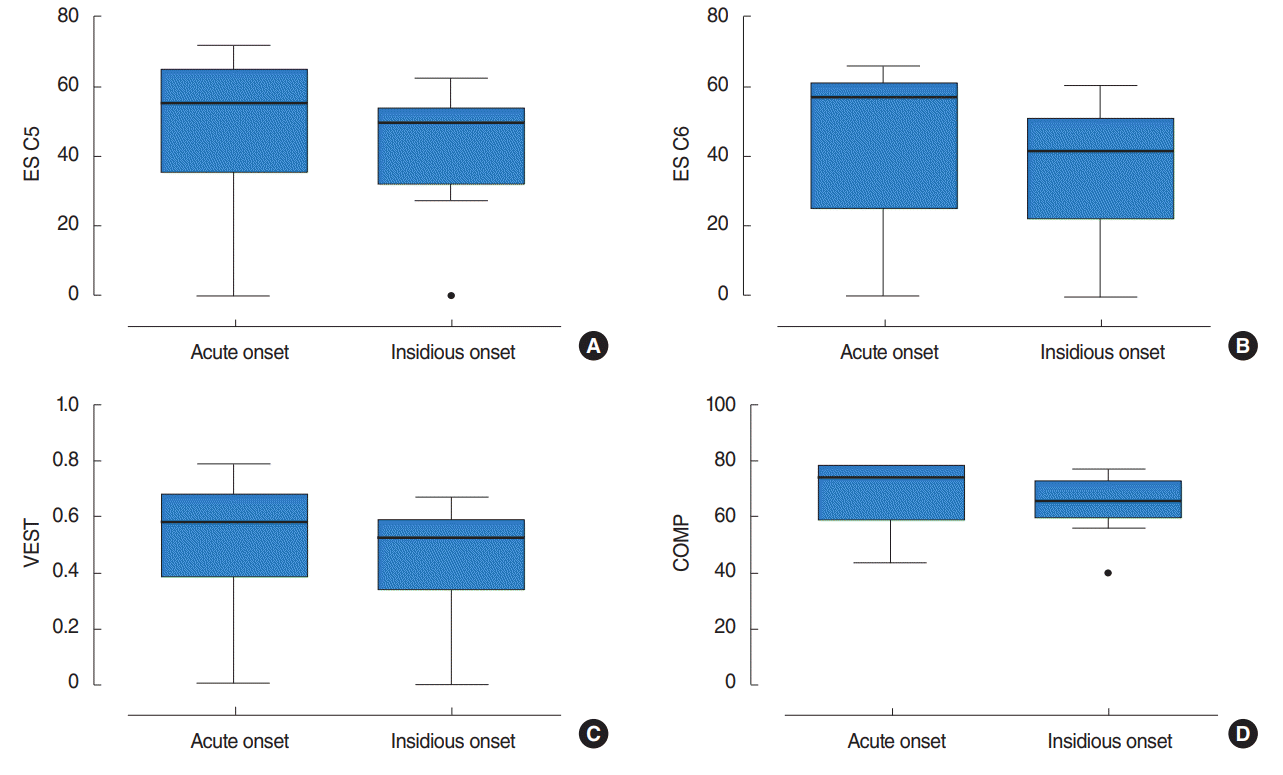1. Kentala E, Pyykko I. Clinical picture of vestibular schwannoma. Auris Nasus Larynx. 2001; Jan. 28(1):15–22.

2. Andersen JF, Nilsen KS, Vassbotn FS, Moller P, Myrseth E, Lund-Johansen M, et al. Predictors of vertigo in patients with untreated vestibular schwannoma. Otol Neurotol. 2015; Apr. 36(4):647–52.

3. Hoffmann CP, Seigle B, Frere J, Parietti-Winkler C. Dynamical analysis of balance in vestibular schwannoma patients. Gait Posture. 2017; May. 54:236–41.

4. Day AS, Wang CT, Chen CN, Young YH. Correlating the cochleovestibular deficits with tumor size of acoustic neuroma. Acta Otolaryngol. 2008; Jul. 128(7):756–60.

5. Gouveris H, Akkafa S, Lippold R, Mann W. Influence of nerve of origin and tumor size of vestibular schwannoma on dynamic posturography findings. Acta Otolaryngol. 2006; Dec. 126(12):1281–5.

6. Gouveris H, Helling K, Victor A, Mann W. Comparison of electronystagmography results with dynamic posturography findings in patients with vestibular schwannoma. Acta Otolaryngol. 2007; Aug. 127(8):839–42.

7. Morrison GA, Sterkers JM. Unusual presentations of acoustic tumours. Clin Otolaryngol Allied Sci. 1996; Feb. 21(1):80–3.

8. Breivik CN, Nilsen RM, Myrseth E, Finnkirk MK, Lund-Johansen M. Working disability in Norwegian patients with vestibular schwannoma: vertigo predicts future dependence. World Neurosurg. 2013; Dec. 80(6):e301–5.

9. Dayal M, Perez-Andujar A, Chuang C, Parsa AT, Barani IJ. Management of vestibular schwannoma: focus on vertigo. CNS Oncol. 2013; Jan. 2(1):99–104.

10. Tranter-Entwistle I, Dawes P, Darlington CL, Smith PF, Cutfield N. Video head impulse in comparison to caloric testing in unilateral vestibular schwannoma. Acta Otolaryngol. 2016; Nov. 136(11):1110–4.

11. Batuecas-Caletrio A, Santa Cruz-Ruiz S, Munoz-Herrera A, Perez-Fernandez N. The map of dizziness in vestibular schwannoma. Laryngoscope. 2015; Dec. 125(12):2784–9.

12. Bergenius J, Magnusson M. The relationship between caloric response, oculomotor dysfunction and size of cerebello-pontine angle tumours. Acta Otolaryngol. 1988; Nov-Dec. 106(5-6):361–7.

13. Stipkovits EM, Van Dijk JE, Graamans K. Electronystagmographic changes in patients with unilateral vestibular schwannomas in relation to tumor progression and central compensation. Eur Arch Otorhinolaryngol. 1999; Apr. 256(4):173–6.

14. Kim HJ, Park SH, Kim JS, Koo JW, Kim CY, Kim YH, et al. Bilaterally abnormal head impulse tests indicate a large cerebellopontine angle tumor. J Clin Neurol. 2016; Jan. 12(1):65–74.

15. Monsell EM, Furman JM, Herdman SJ, Konrad HR, Shepard NT. Computerized dynamic platform posturography. Otolaryngol Head Neck Surg. 1997; Oct. 117(4):394–8.
16. Gouveris H, Stripf T, Victor A, Mann W. Dynamic posturography findings predict balance status in vestibular schwannoma patients. Otol Neurotol. 2007; Apr. 28(3):372–5.

17. Ribeyre L, Frere J, Gauchard G, Lion A, Perrin P, Spitz E, et al. Preoperative balance control compensation in patients with a vestibular schwannoma: does tumor size matter? Clin Neurophysiol. 2015; Apr. 126(4):787–93.

18. Koos WT, Spetzler RF, Bock FW. Microsurgery of cerebellopontine angle tumors. In : Koos WT, Bock FW, Spetzler RF, Ammerman B, editors. Clinical microneurosurgery. Stuttgart: Georg Thieme;1976. p. 91–112.
19. Neurocom International Inc. EquiTest system operator’s manual version 8.2. Clackamas: Neurocom International Inc;2004.
20. Dilwali S, Landegger LD, Soares VY, Deschler DG, Stankovic KM. Secreted factors from human vestibular schwannomas can cause cochlear damage. Sci Rep. 2015; Dec. 5:18599.

21. Yin M, Ishikawa K, Omi E, Saito T, Itasaka Y, Angunsuri N. Small vestibular schwannomas can cause gait instability. Gait Posture. 2011; May. 34(1):25–8.

22. Myrseth E, Moller P, Wentzel-Larsen T, Goplen F, Lund-Johansen M. Untreated vestibular schwannomas: vertigo is a powerful predictor for health-related quality of life. Neurosurgery. 2006; Jul. 59(1):67–76.





 Citation
Citation Print
Print


 XML Download
XML Download